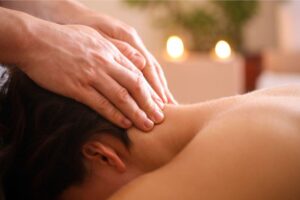Bowling is generally considered a low-impact sport however certain factors associated with bowling technique and equipment can potentially lead to discomfort or even neck pain.
This article aims to traverse the relationship between bowling and neck pain, expounding on the possible causes and offering insights on how to prevent or alleviate this common issue.
By understanding the impact of bowling on the neck, it will allow you to take proactive measures to ensure a pain-free bowling experience.
Can Bowling Cause Neck Pain?
Yes, bowling can potentially cause neck pain. The repetitive motion of swinging the bowling ball, coupled with poor technique or improper form, can strain the muscles and ligaments in the neck, leading to discomfort or pain. It is important to maintain proper posture, warm up adequately, and use appropriate bowling techniques to minimize the risk of developing neck pain while bowling.
The Impact of Repetitive Bowling Movements on the Neck
The repetitive movements associated with bowling can have a significant impact on the neck. When you bowl, you engage in a series of repetitive motions such as swinging the ball, releasing it, and following through with your arm.
These actions place strain on the muscles and ligaments of the neck, especially if proper technique and form are not maintained.
Over time, this repetitive stress can lead to muscle imbalances, tension, and discomfort in the neck region.
One key factor contributing to the impact on the neck is the weight of the bowling ball. Depending on your strength and technique, repeatedly lifting and swinging a heavy ball can strain the muscles of the neck.
The force exerted during the release and follow-through can also add to the stress placed on the neck structures. Consequently, if the neck muscles are not properly conditioned or if excessive force is exerted, it can result in neck pain and stiffness.
Furthermore, poor posture and body mechanics during bowling can exacerbate the impact on the neck.
Many bowlers tend to tilt their heads forward or to the side while focusing on their aim or the trajectory of the ball.
This position places additional strain on the neck muscles, leading to discomfort or pain.
It is fundamental to maintain proper posture, keeping the neck in alignment with the spine, to minimize the risk of developing neck issues caused by repetitive bowling movements.
Common Causes of Neck Pain in Bowling
1. Incorrect Bowling Technique: One of the primary causes of neck pain in bowling is using incorrect technique. Improper form, such as tilting the head forward or to the side during the delivery, places strain on the neck muscles and can lead to discomfort or pain.
It is essential to maintain proper posture and alignment throughout the bowling motion to avoid undue stress on the neck.
2. Muscle Imbalances and Weakness: Bowling primarily engages specific muscle groups, such as the shoulder, arm, and neck muscles.
However, if these muscles are not properly balanced or conditioned, it can result in increased stress on the neck.
Weak neck muscles may struggle to support the repetitive motions involved in bowling, leading to strain and subsequent neck pain.
3. Overexertion and Fatigue: Bowling is a physically demanding activity that requires repetitive movements and muscular effort.
Overexertion, particularly in the upper body and neck region, can lead to muscle fatigue and strain. When the muscles become fatigued, they are more prone to injuries and increased discomfort in the neck area.
4. Lack of Warm-up and Stretching: Failing to properly warm up before bowling can contribute to neck pain. Without adequate warm-up exercises, the muscles and joints of the neck may not be sufficiently prepared for the demands of the sport.
Stretching the neck and upper body before bowling can help improve flexibility, reduce tension, and minimize the risk of neck pain.
5. Bowling Ball Weight and Gripping Pressure: The weight of the bowling ball can impact the neck, especially if it exceeds a comfortable limit for the bowler. Using a ball that is too heavy can strain the muscles of the neck during the swing and release.
Additionally, gripping the ball too tightly can lead to increased tension and strain in the neck and shoulder area.
By addressing these common causes of neck pain in bowling, such as correcting technique, improving muscle balance and strength, incorporating proper warm-up routines, and using an appropriately weighted ball, bowlers can reduce the risk of developing neck pain and enjoy a more comfortable and rewarding bowling experience.
The Importance of Proper Technique and Form
Proper technique and form are crucial in bowling not only for achieving better results but also for minimizing the risk of injuries, including neck pain. Here’s why:
1. Injury Prevention: Employing correct technique and form while bowling helps distribute the forces exerted on the body more evenly, reducing the strain on specific areas like the neck.
Maintaining proper posture and alignment throughout the bowling motion ensures that the muscles and joints of the neck are not subjected to unnecessary stress, minimizing the likelihood of developing neck pain or injuries.
2. Efficient Energy Transfer: Proper technique allows for efficient energy transfer from the body to the bowling ball. By utilizing the correct body mechanics, including a smooth and coordinated approach, a controlled swing, and a balanced follow-through, bowlers can generate power without relying excessively on the neck muscles.
This efficient energy transfer reduces the strain on the neck and helps maintain a more fluid and sustainable bowling motion.
3. Muscle Balance and Control: Good technique promotes better muscle balance and control throughout the body, including the neck muscles. A balanced and controlled approach to bowling reduces the risk of overcompensation by specific muscles and helps distribute the workload evenly.
This balance reduces the likelihood of muscle imbalances and tension in the neck, enhancing overall neck health and reducing the potential for pain.
4. Consistency and Accuracy: Proper technique and form enhance consistency and accuracy in bowling. By developing and maintaining a consistent technique, bowlers can reduce the variability in their movements, resulting in a more repeatable and controlled delivery. Consistency in bowling reduces the likelihood of sudden or jerky motions that could strain the neck and cause discomfort.
5. Long-Term Enjoyment: Adopting and practicing proper technique and form in bowling can contribute to long-term enjoyment of the sport.
By prioritizing proper mechanics and minimizing the risk of injury, bowlers can continue participating in the activity with reduced discomfort or pain, allowing for a more sustainable and fulfilling bowling experience over time.
By focusing on proper technique and form, bowlers can not only improve their performance but also promote neck health and reduce the risk of developing neck pain or injuries.
It is beneficial to seek guidance from experienced coaches or trainers to learn and refine the correct bowling techniques, ensuring a more enjoyable and pain-free bowling journey.
How Bowling Equipment Can Influence Neck Health

The choice and usage of bowling equipment can have a significant impact on neck health. The weight of the bowling ball is influential.
Using a ball that is too heavy for your strength and capabilities can strain the muscles and joints of the neck.
Opting for a ball that you can comfortably handle and control during your swing and release is essential to prevent excessive stress on the neck.
The grip and finger inserts in the bowling ball play a vital role. A well-fitted grip allows for a secure hold on the ball, reducing the need to grip it tightly and decreasing tension in the neck and shoulder area.
Similarly, properly fitting finger inserts enhance control and reduce strain on the fingers, consequently minimizing strain on the neck during the release.
The type and quality of bowling shoes can impact stability and balance during the approach and delivery. Shoes that provide good support and grip help maintain proper body alignment and prevent excessive compensatory movements that can strain the neck.
Wearing well-fitting and appropriate bowling shoes promotes stability and reduces the risk of falls or awkward movements that could impact the neck.
The surface of the bowling ball and the lane conditions can affect the amount of friction and resistance experienced during the delivery.
Bowling balls with excessive surface roughness or lane conditions that require more forceful throws can lead to increased strain on the neck.
It is important to select a ball with a suitable surface and be aware of the lane conditions to adjust your technique accordingly and minimize unnecessary stress on the neck.
By carefully considering and optimizing bowling equipment, such as selecting an appropriate ball weight, ensuring a proper grip and finger inserts, and wearing supportive shoes, bowlers can prioritize neck health and reduce the likelihood of discomfort or pain.
It is also beneficial to seek guidance from professionals, such as bowling pro shop experts or coaches, to ensure proper equipment selection and maintenance, thereby enhancing the overall bowling experience while safeguarding neck well-being.
Preventive Measures to Avoid Neck Pain while Bowling
Preventing neck pain while engaging in the sport of bowling requires a proactive approach. Here are four key preventive measures that can help bowlers avoid neck pain:
1. Proper Warm-up and Stretching: Before stepping onto the bowling lane, it is crucial to engage in a comprehensive warm-up routine.
This should include dynamic stretching exercises that target the neck, shoulders, and upper body.
Warming up prepares the muscles and joints for the physical demands of bowling, promoting better blood flow, flexibility, and reducing the risk of strain or injury.
2. Maintain Proper Posture and Alignment: Maintaining proper posture throughout the bowling motion is essential to prevent neck pain.
Focus on aligning the neck with the spine, avoiding excessive tilting or twisting of the head. Engage the core muscles to support good posture, and be mindful of maintaining a balanced and relaxed stance.
Proper posture distributes the forces evenly and minimizes strain on the neck muscles.
3. Strengthen and Stretch Neck Muscles: Incorporating exercises to strengthen and stretch the neck muscles into your fitness routine can significantly reduce the risk of neck pain.
Strengthening exercises, such as neck isometrics or resistance training, help build muscle endurance and stability. Stretching exercises, such as neck rotations and side stretches, improve flexibility and release tension in the neck.
Consult with a healthcare professional or a qualified trainer to learn specific exercises tailored to your needs and limitations.
4. Listen to Your Body and Take Regular Breaks: It’s essential to listen to your body’s cues and take regular breaks during extended bowling sessions. Pay attention to any signs of discomfort, tension, or fatigue in the neck area.
When you feel these signals, take a moment to rest, stretch, and relax your neck muscles. Taking regular breaks allows your neck muscles to recover, prevents overuse injuries, and reduces the likelihood of developing neck pain.
By implementing these preventive measures, bowlers can significantly decrease the risk of experiencing neck pain while enjoying the sport.
It’s important to consult with professionals, such as coaches or healthcare providers, to ensure you are performing exercises correctly and safely.
Taking a proactive approach to neck health will not only enhance your bowling performance but also promote a more enjoyable and pain-free experience on the lanes.
Related post: Can Bowling Hurt Your Wrist?
Stretching and Strengthening Exercises for Neck Health
To promote neck health and prevent pain or discomfort while bowling, incorporating stretching and strengthening exercises into your routine can be highly beneficial. Here are some effective exercises to consider:
1. Neck Stretches: Gently tilt your head forward, backward, and to each side, holding each position for 15-30 seconds. You can also perform gentle neck rotations, turning your head from side to side. These stretches help release tension in the neck muscles and improve flexibility.
2. Chin Tucks: Sit or stand with your spine straight. Slowly retract your chin by pulling it inward towards your throat without tilting your head up or down. Hold the position for a few seconds and repeat several times.
This exercise strengthens the muscles at the front of the neck, promoting better posture and reducing strain.
3. Neck Isometrics: Place your hand on your forehead and gently push your head forward while simultaneously resisting the pressure with your neck muscles. Hold for a few seconds and repeat several times. Repeat the same process with your hand on the back of your head, pushing backward and resisting the pressure. These isometric exercises help strengthen the neck muscles and improve stability.
4. Shoulder Shrugs: Elevate your shoulders towards your ears, hold for a few seconds, and then release. Repeat this movement several times. Shoulder shrugs help alleviate tension in the neck and shoulder muscles, promoting relaxation and reducing the risk of strain.
5. Upper Back Stretch: Interlace your fingers in front of you and push your hands away from your body while rounding your upper back. Hold the stretch for 15-30 seconds, feeling a gentle stretch in your upper back and neck.
This exercise helps counteract the forward posture often associated with bowling and improves flexibility in the upper back and neck region.
Remember to perform these exercises in a slow and controlled manner, avoiding any sudden or jerky movements. If you have any pre-existing neck conditions or concerns, it is advisable to consult with a healthcare professional or physical therapist before starting any exercise program.
Incorporating these stretching and strengthening exercises into your routine can help maintain neck health, reduce the risk of discomfort, and enhance your overall bowling experience.
Seeking Professional Help: When to Consult a Healthcare Provider
While preventive measures and self-care practices can often alleviate neck pain associated with bowling, there are instances when it is necessary to consult a healthcare provider.
Here are some situations where seeking professional help is recommended:
1. Limited Range of Motion: If you notice a significant decrease in your neck’s range of motion or have difficulty moving your head in certain directions, it is recommended to consult a healthcare provider.
Limited range of motion can be indicative of musculoskeletal issues, such as muscle strains, joint problems, or even cervical spine issues that may require further assessment and management.
2. Numbness, Tingling, or Weakness: If you experience accompanying symptoms like numbness, tingling, or weakness in the neck, shoulders, arms, or hands, it may indicate nerve involvement.
These symptoms could be related to nerve compression or other neurological issues that require prompt medical evaluation.
3. Previous Neck Injuries or Conditions: If you have a history of neck injuries, such as whiplash, or pre-existing neck conditions like cervical disc herniation or arthritis, it is important to consult a healthcare provider before engaging in bowling or if you experience any exacerbation of symptoms.
They can provide specific guidance and recommendations based on your individual condition to prevent further injury or manage any flare-ups effectively.
4. Lack of Improvement: If you diligently follow preventive measures, rest, and self-care techniques for neck pain associated with bowling but notice little to no improvement after a reasonable period, it is advisable to seek professional help.
A healthcare provider can assess your condition, conduct a thorough examination, and provide appropriate treatment options to address the underlying cause of your neck pain.
Healthcare providers, such as primary care physicians, orthopedic specialists, chiropractors or physical therapists, are trained to evaluate and manage musculoskeletal conditions, including neck pain.
If you are unsure whether your symptoms warrant medical attention, it is always better to err on the side of caution and consult with a healthcare professional who can provide proper guidance and personalized care.
Related post: Does Bowling Make You Sore?
Tips for Post-Bowling Neck Pain Relief and Recovery

If you experience neck pain after bowling, there are several tips and techniques you can follow to promote relief and aid in the recovery process. Here are some helpful suggestions:
1. Rest and Ice: Give your neck a break and allow it to rest. Avoid activities that aggravate the pain and apply ice packs wrapped in a thin cloth to the affected area.
Ice helps reduce inflammation and can provide temporary pain relief. Apply ice for about 15 minutes at a time, several times a day.
2. Gentle Neck Exercises: Engage in gentle range of motion exercises to promote mobility and alleviate stiffness. Slowly move your neck in various directions, such as tilting your head forward and backward, rotating it from side to side, and gently stretching the neck muscles.
Be cautious not to overexert or strain the neck further, and discontinue any exercise that causes increased pain.
3. Over-the-Counter Pain Medication: Non-prescription pain relievers such as acetaminophen or nonsteroidal anti-inflammatory drugs (NSAIDs) may help alleviate discomfort and reduce inflammation.
Follow the recommended dosage guidelines and consult with a healthcare professional if you have any underlying medical conditions or are taking other medications.
4. Heat Therapy: After the initial acute phase, when the pain and inflammation have subsided, you can consider applying heat to the neck area. Use a heating pad, warm towel, or take a warm shower to help relax the muscles and improve blood circulation.
However, avoid using heat during the acute phase or if you have an active inflammation or swelling.
5. Massage and Stretching: Consider gentle neck massages or seek the assistance of a licensed massage therapist who is experienced in treating neck pain.
Additionally, perform gentle stretching exercises for the neck to improve flexibility and relieve muscle tension. It’s important to be cautious and avoid any aggressive or forceful manipulation of the neck.
6. Seek Professional Help: If the neck pain persists or worsens despite self-care measures, it is advisable to consult a healthcare professional.
They can assess your condition, provide a proper diagnosis, and recommend specific treatment options such as physical therapy, chiropractic care, or further medical intervention if necessary.
Everyone’s pain and recovery process can vary, so it’s important to listen to your body and give yourself adequate time to heal.
If you have any concerns or questions about your neck pain or recovery, it’s always best to consult with a healthcare professional for personalized advice and guidance.
Enjoying Bowling with a Healthy Neck
Maintaining a healthy neck while enjoying the sport of bowling is key for a pain-free and fulfilling experience.
By understanding the impact of repetitive bowling movements, prioritizing proper technique and form, considering the influence of bowling equipment on neck health, and implementing preventive measures such as stretching and strengthening exercises, bowlers can reduce the risk of neck pain and injuries.
It is essential to listen to your body, take breaks when needed, and seek professional help when necessary.
Consulting with a healthcare provider, particularly in cases of persistent or severe pain, limited range of motion, or accompanying neurological symptoms, can ensure proper diagnosis and appropriate treatment.
By being proactive in caring for your neck, you can continue to enjoy the sport of bowling, improve your performance, and foster a long-lasting passion for the game.



